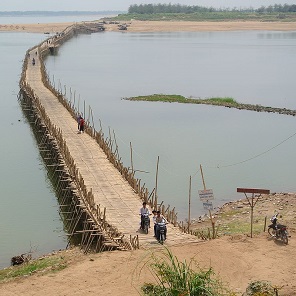Bamboo is a promising green feedstock. It is not only used for construction (approximately 1 billion people live in bamboo homes), we can now also make clothing from it and eat it. It is one of the fastest growing plants on earth, grows on degraded soils and does not need fertilizer or irrigation when cultivated.
 Economic properties
Economic properties
Bamboo grows up to 1 meter per day, and yield in the most productive areas can reach over 160 tonnes per ha. Such high amounts occur mostly in the ‘moso’ forests in China, which is forest dominated by Phyllostachys heterocycla var. pubescens, and which tends to occupy the most productive soils and covers 70% of all bamboo forest in China. The largest amount of land cover however is in India, which contains twice as much bamboo forest as China does. The difference in productivity between Chinese and Indian forests is mostly due to differences in species. In 2005, the year of the most recent international survey, international trade amounted to USD 2.5 billion. The number of people economically dependent on bamboo is also 2.5 billion however, and the largest part of trade occurs nationally.
Ecological properties
Bamboo needs little help to grow. It requires no fertilizer and no pesticides and has no trouble growing on slopes and degraded soils. In fact, this was the first visible plant life to return after the atomic bombardment of Nagasaki and Hiroshima in 1945. There are about 1200 species of which 500 can be found in China. Genetically speaking bamboo is a grass (member of the Gramineae), and the most important distinction between bamboos is whether they are monopods or sympods. Monopods (mostly the geni Phyllostachys and Pleioblastus) spread through horizontal runners and can also grow in colder climates, e.g. in parts of Europe. They grow in open clods and spread quickly. They are therefore considered invasive in many parts of the world. Symbods (mostly the genus Bambusa) only grow in tropical climates and can be recognised by growing in distinct clumps. Over half of all bamboo in the world grows in Asia, yet Africa and South America together still contribute a third to the global forest. Forest for production usually grows on slopes and marginal lands, although at times natural forests have also been harvested with environmentally detrimental effects.

Applications
Bamboo has to be processed before use, but is in some cases superior to wood. It has a low expansion and shrink rate and after treatment is relatively resistant to moisture compared to wood. It’s calorific value per kg is half that of oil, and the charcoal is also used as absorbent in medical and cleaning applications. It is light and easy to transport, which contributes to its usefulness as construction material. Experts guess that about 1 billion people worldwide live in bamboo huts. The material is also processed into floors and windowsills, which is mostly done in China but is a growing market in Europe. A major producer of bamboo-based building materials is MOSO International, operating from the Netherlands. In Africa the majority of production is used for fuel. The international market consists mostly of food products and products such as woven baskets.
Bamboo can also be processed into fibres. Then the material is first turned into blocks or strands, which can be chemically processed into fibre. This process can be ecologically harmful. So-called viscose products require cooking and drenching in lye before treatment with the toxic carbondisulphide. The Austrian company Lenzing has recently developed an alternative process based on NMMO (N-Methylmorpholinoxide). This process works with a closed system and is much more environmentally friendly than the viscose process. They already apply this process to produce both eucalyptus and bamboo-based fibres, marketed respectively as Tencel and Lyocell.
Versatile bamboo
There is a surge of interest for bamboo and products based on it coming from Europe and the US. Lenzing’s NMMO-based process is only one example of recent developments, and we expect many more such developments in the near future. Bamboo is already extensively used in developing countries and has the potential to become a valuable feedstock. Under the (at present) usual circumstances it has a low ecological footprint; and its versatility could make it an interesting feedstock for clothing and other applications in the biobased economy.
The author wishes to thank Erwin van Woudenberg for background information.
